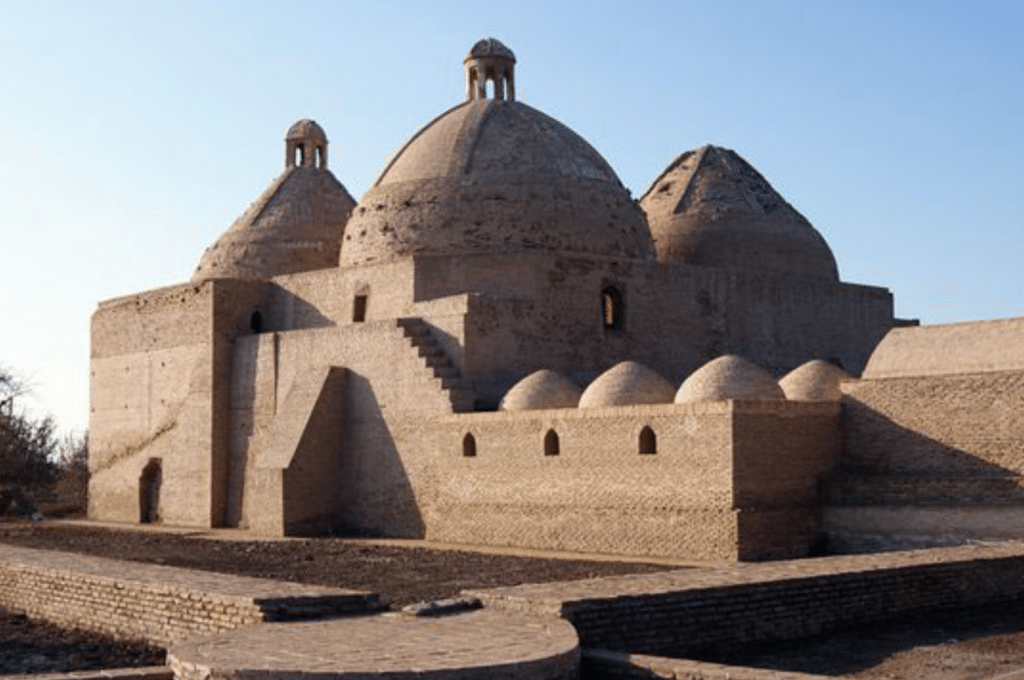Astana Baba
Astana Baba Mausoleum
Astana-Baba mausoleum located 12 km northwest of the town of Atamurat at the side of the road. The villages lie 190 km southeast of Turkmenabad. It is a historic site located in the city of Turkmenabat, which is the capital of the Lebap Region of Turkmenistan. Astana-Baba is a mausoleum dates back to the 15th century and is considered one of the most significant monuments of Islamic architecture in Central Asia. Today, the Astana Baba Mausoleum is a popular tourist attraction in Turkmenistan and is also still used as a place of worship by local Muslims.
The mausoleum was built in honor of the Muslim mystic and philosopher Astana Baba, who is believed to have lived in the area during the 14th century. The site became a place of pilgrimage and worship for many Muslims, and the mausoleum was constructed to house the saint’s tomb.
A whole complex is a place of shrine pilgrimage. “Astana” from the Farsi means “mausoleum” and it is unclear who is buried beneath the various tombs. The identity of an Astana-baba is unknown. Although the spot where the mausoleum stands is considered sacred and healing. Thousands of sick people gather there annually to receive long-awaited healing. The number of pilgrims grows with each year. The complex includes the mausoleums of Zed-Ali and Zuveid-Ali.

Astana Baba mausoleum structure
The Astana Baba Mausoleum is a beautiful example of Timurid-era architecture, featuring intricate brickwork and stunning tilework. The entrance to the mausoleum is decorated with an ornate arch, and the interior is adorned with colorful mosaics and calligraphy.
Astana-baba Mausoleum consists of a tomb and a mosque as well and they belong to various periods. This is an unusual and attractive complex, consisting of four domed rooms, made by way of a brick corridor beyond the portal, the corridor leading into a now roofless four-pillared hall before reaching the first of the domed rooms. The two westernmost domed rooms, those furthest from the entrance, each contain two tombs. The structure has been progressively enlarged, and several times altered, over the centuries. The oldest part of the complex seems to hold the two easternmost domed rooms, one of them a mosque, the other containing a single tomb, which dates from the 12th century. The portal and the twin-tombed room known as the Kizlyar-Bibi Mausoleum are among the most recent additions, probably 19th century.
Astana Baba Legend
There is a legend about them runs: “The ruler of Balkh (medieval Khurasan) had a beautiful daughter Zuveida. She married the viceroy of the territory but soon after the wedding she died. The mournful father brought the best masters from Merv and Samarkand so that they constructed a beautiful mausoleum in his daughter’s memory. However, the mausoleum collapsed right after it had been built. The same happened to the next one and so did to the third. The father was desperate but soon an old man advised him to erect the mausoleum from clay and the water brought from Mecca. The heartbroken father did as he had been told. The soil was mixed with the clay brought from Mecca and the water from Mecca was poured into a well and was used for construction. Soon the mausoleum was completed and after the death of the ruler his body was buried next to his daughter “.
Alamberdan Mausoleum
The Mausoleum of Allamberadar mausoleum lies 1 km northwest of Astana-baba mausoleum. Allamberadar mausoleum is an 11th-century monument of architecture. The structure of the mausoleum is the largest among the existing early structures of Northern Khurasan. The mausoleum reveals the particular features of Central Asian monumental architecture of the “Golden Age” ( the epoch of Seljukids). Primarily, it is the significant size of the building and unusual facade decoration which presents richly decorated with an ornamental laying with fancy carved little bricks
Residents believe that the mausoleum is the place of burial of a standard-bearer of the Prophet. While there is no clear answer for whom the mausoleum was built, written sources show that the last Samanid ruler, Abu Ibrahim Ismail Muntazir, was killed in this general area in 1004. Some historians suggest that Alamberdar might be the symbolic mausoleum of Muntazir.
Other sights next to Astana baba Mausoleum
Page updated 21.4.2023